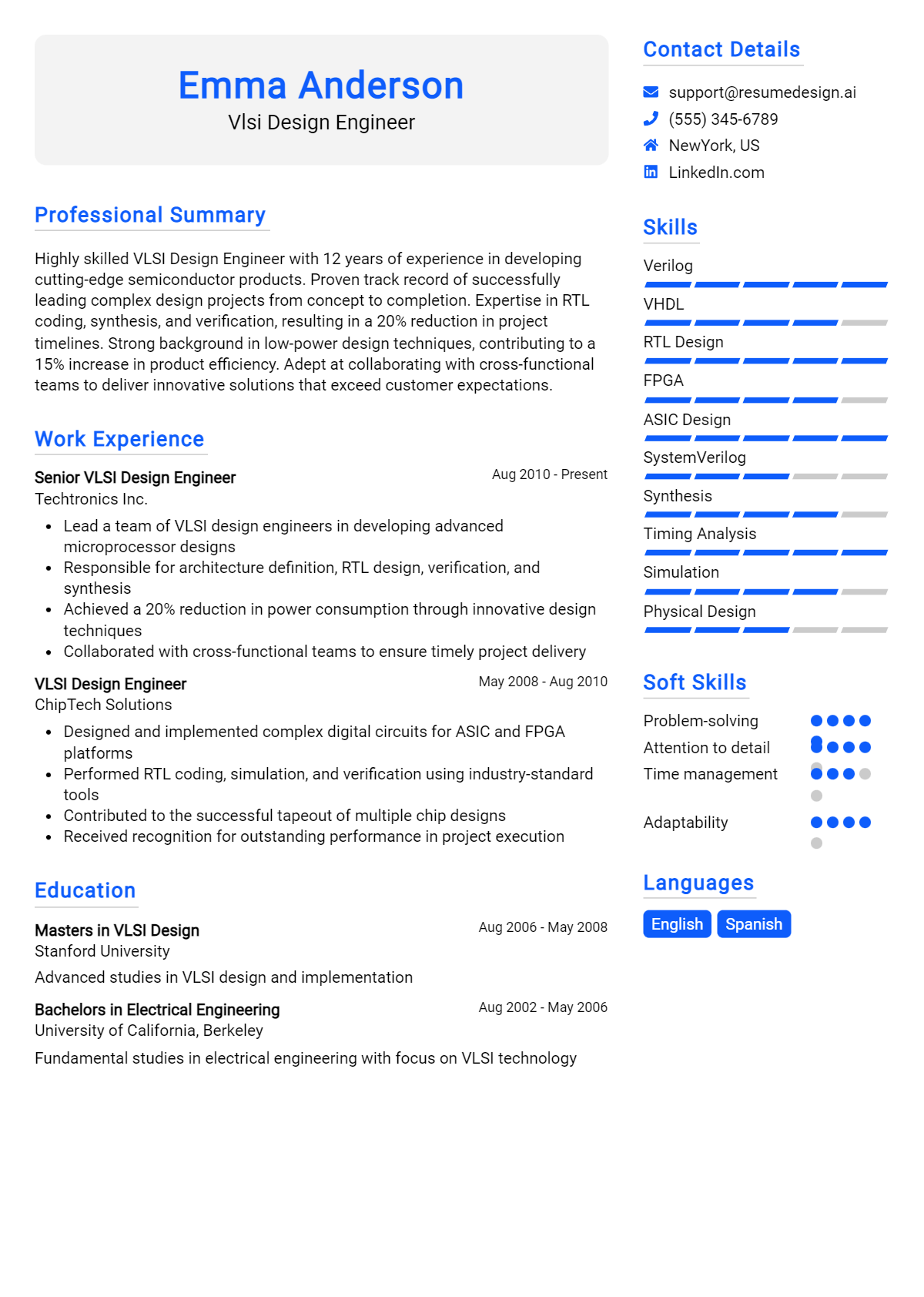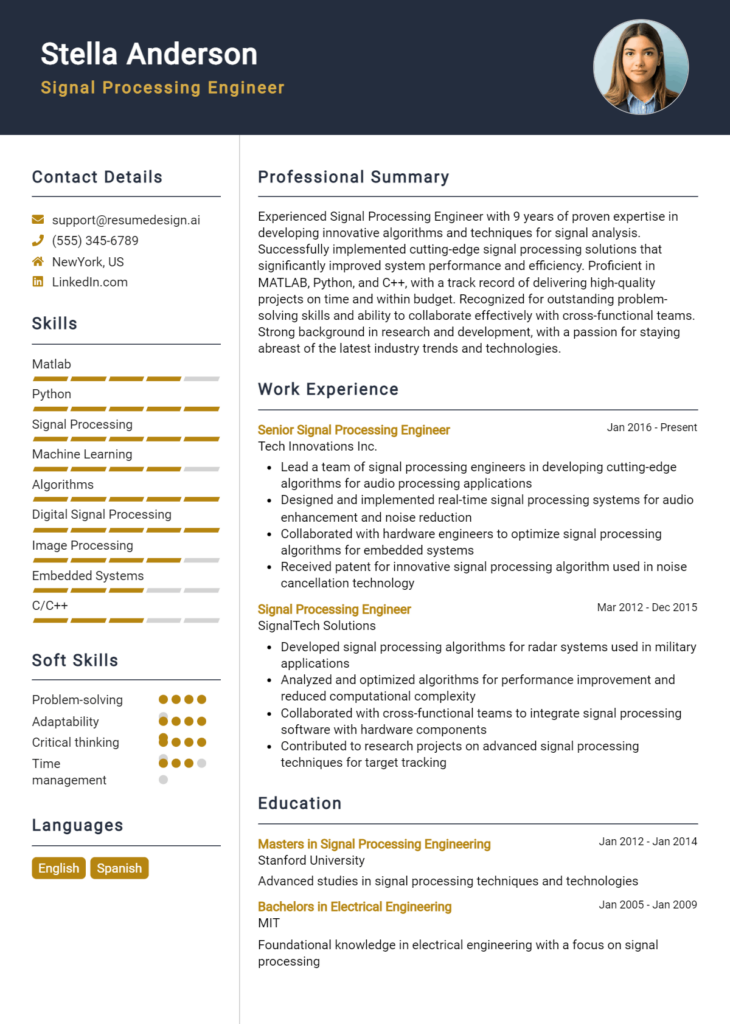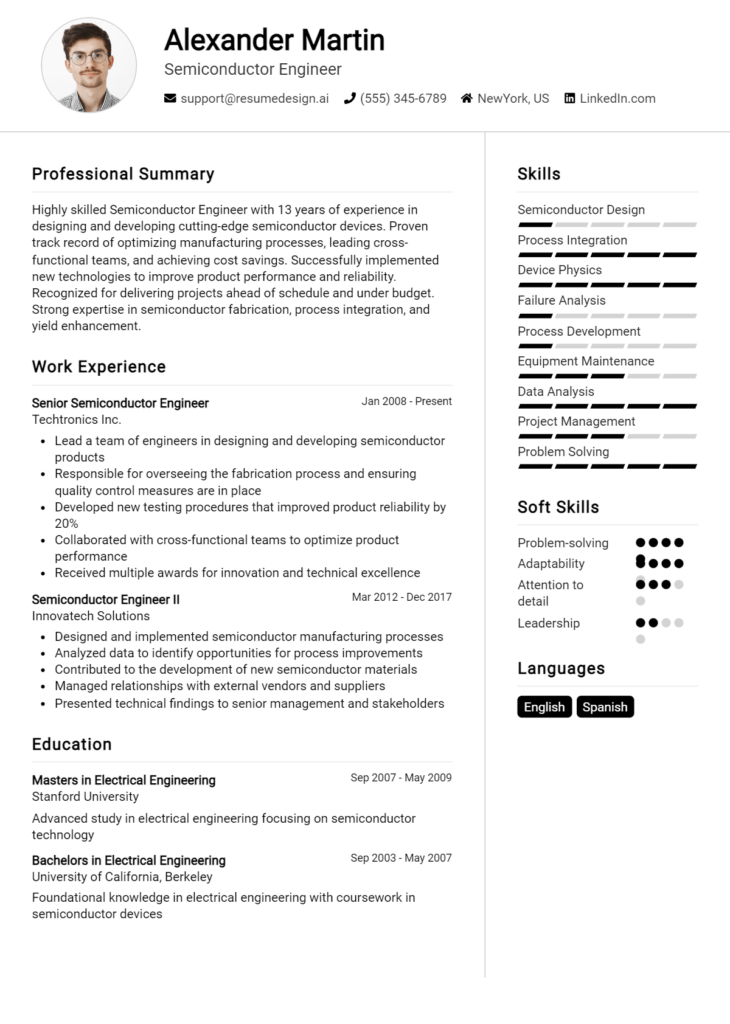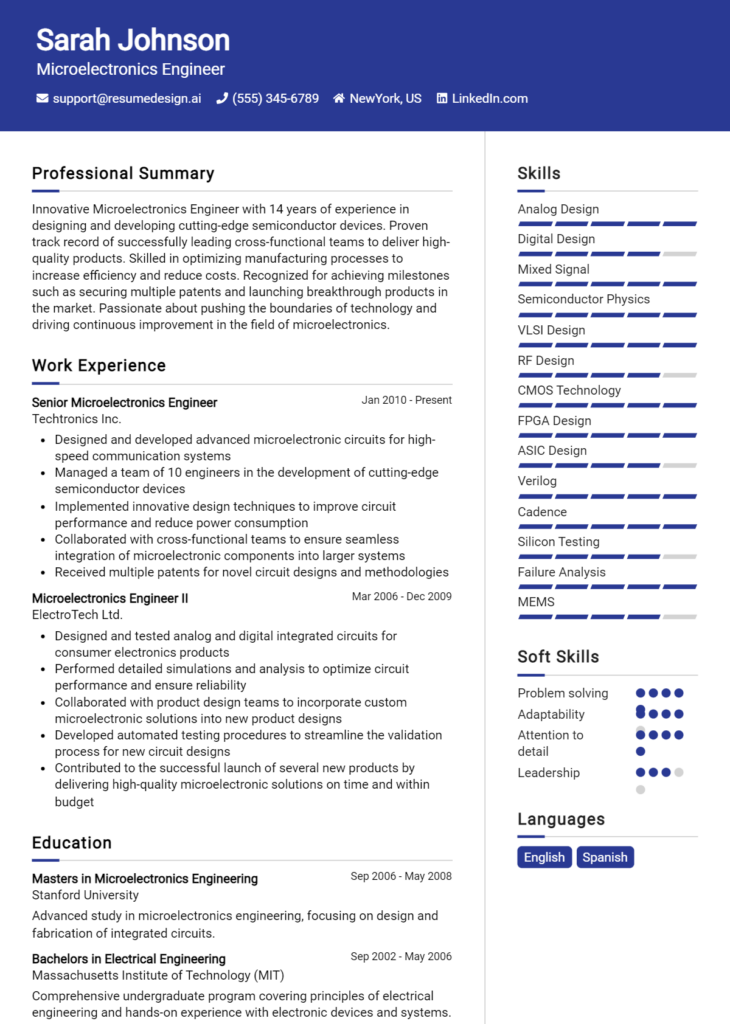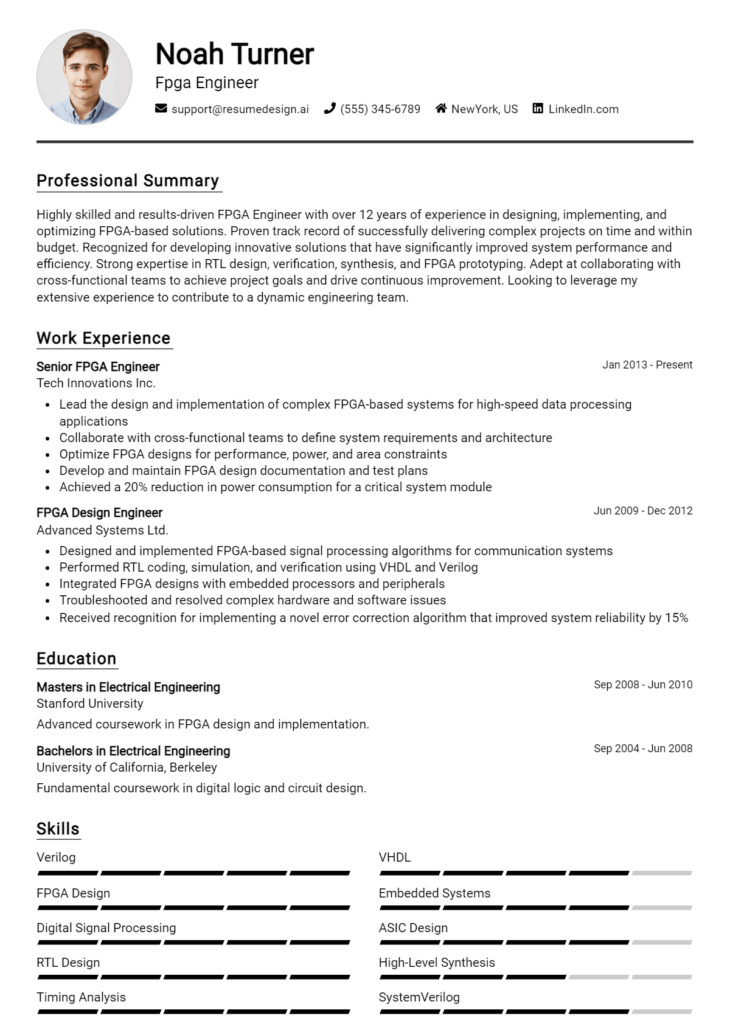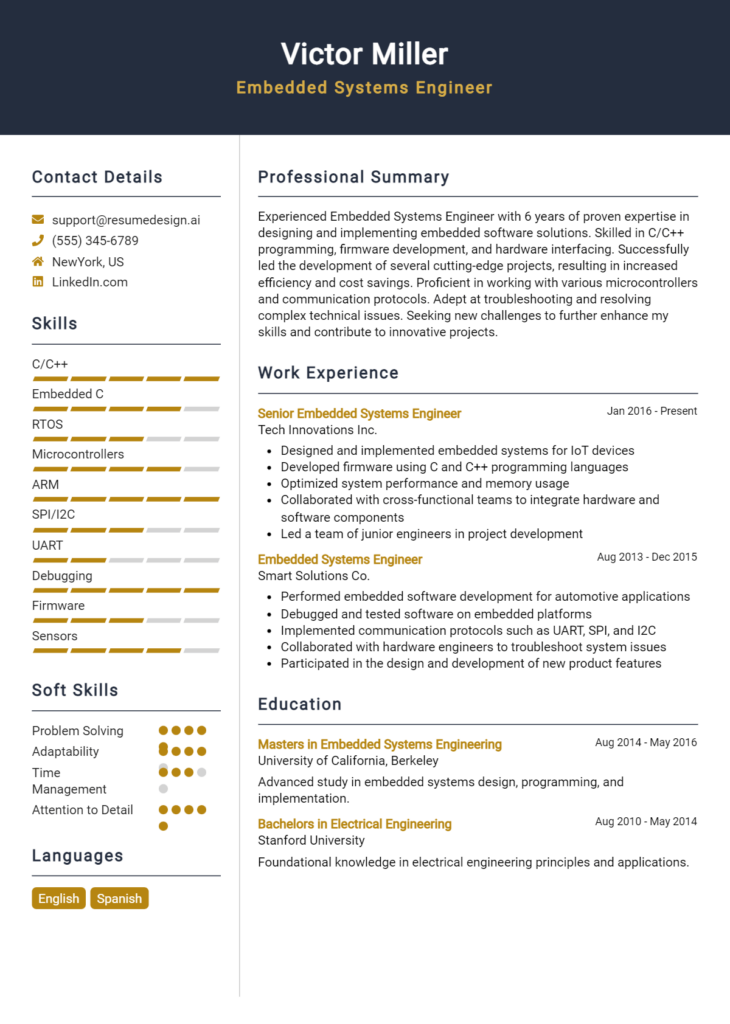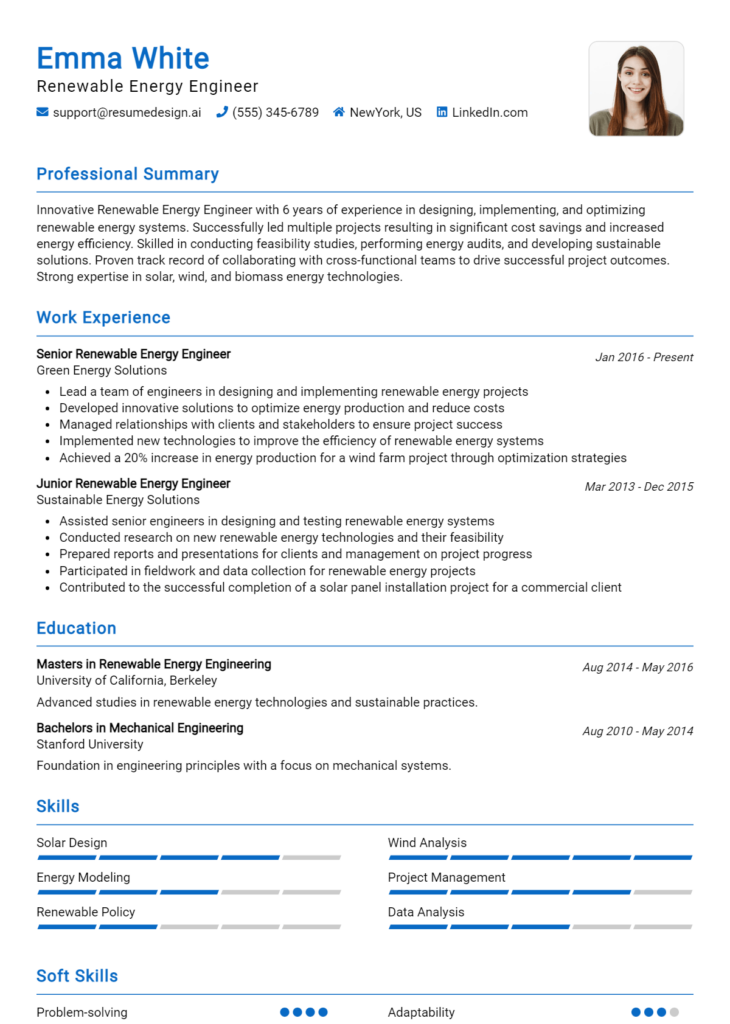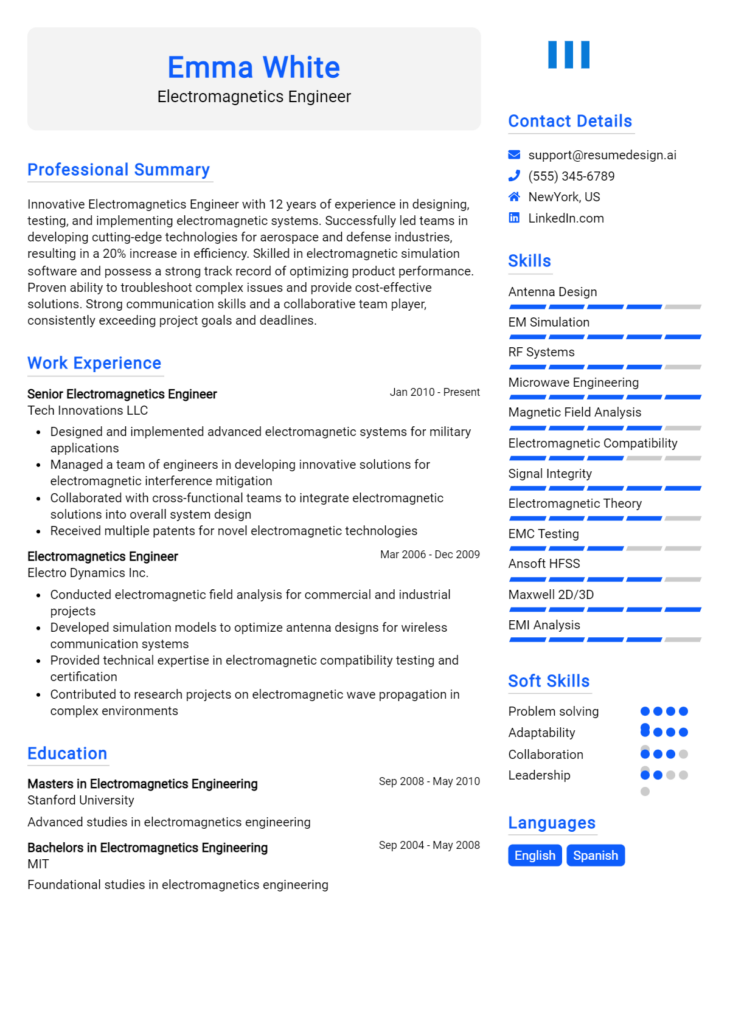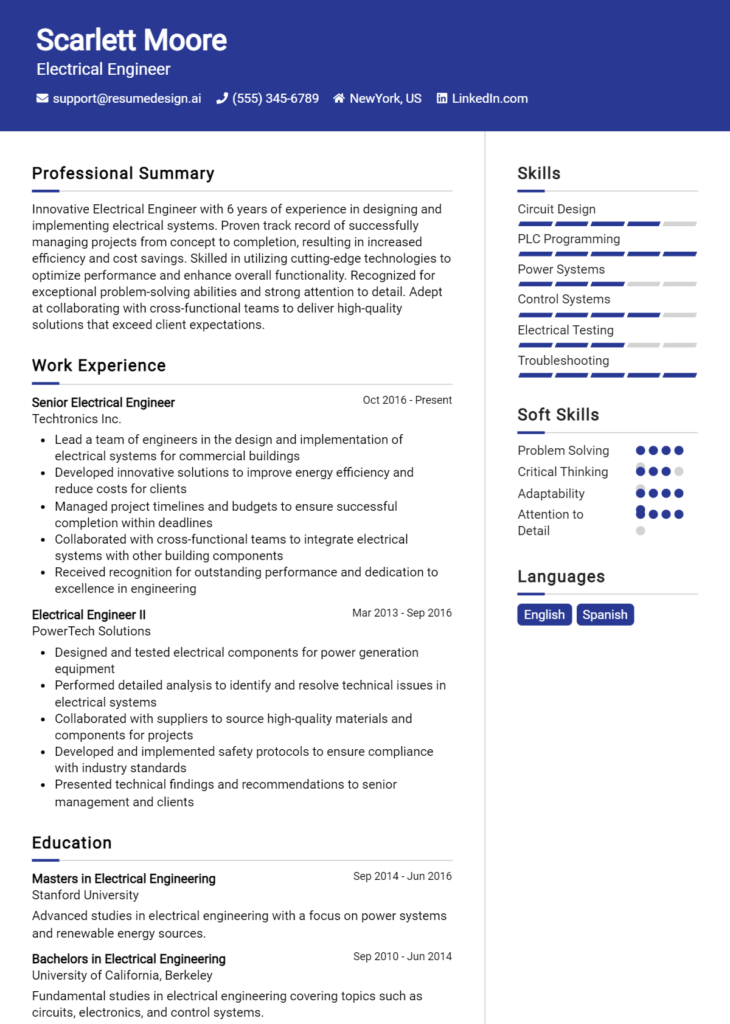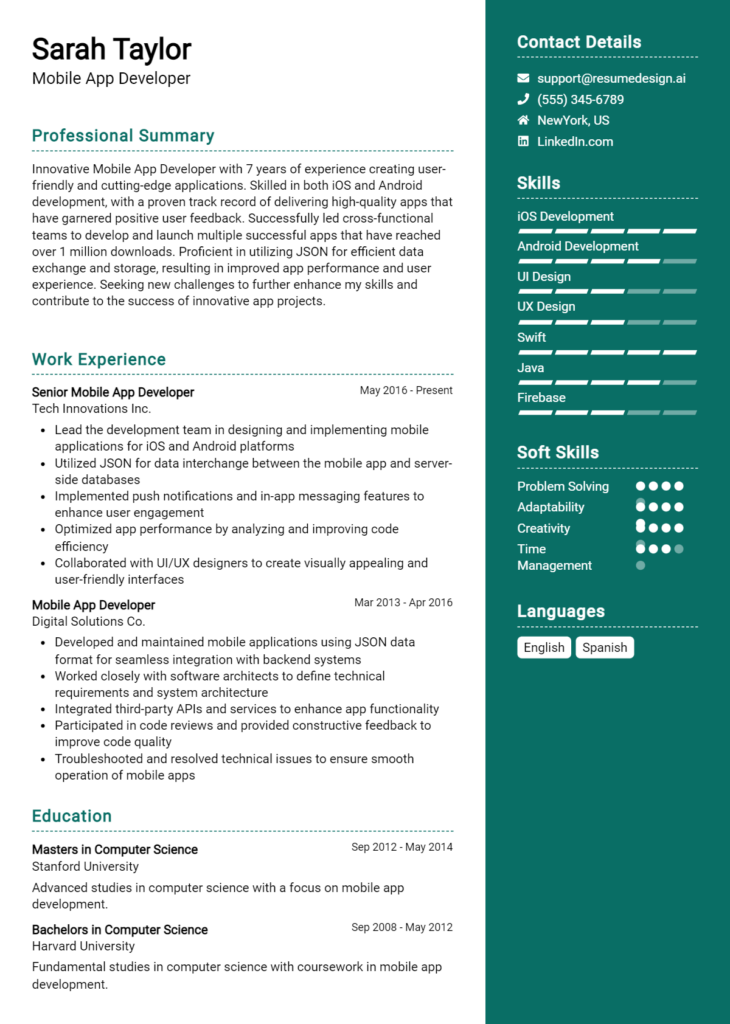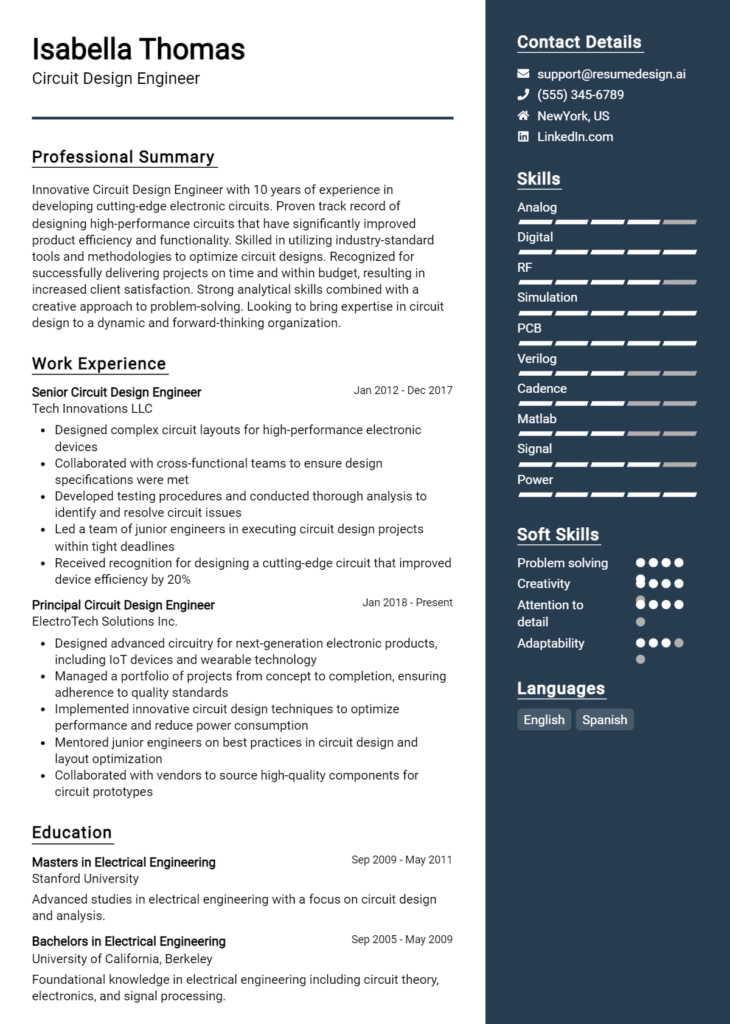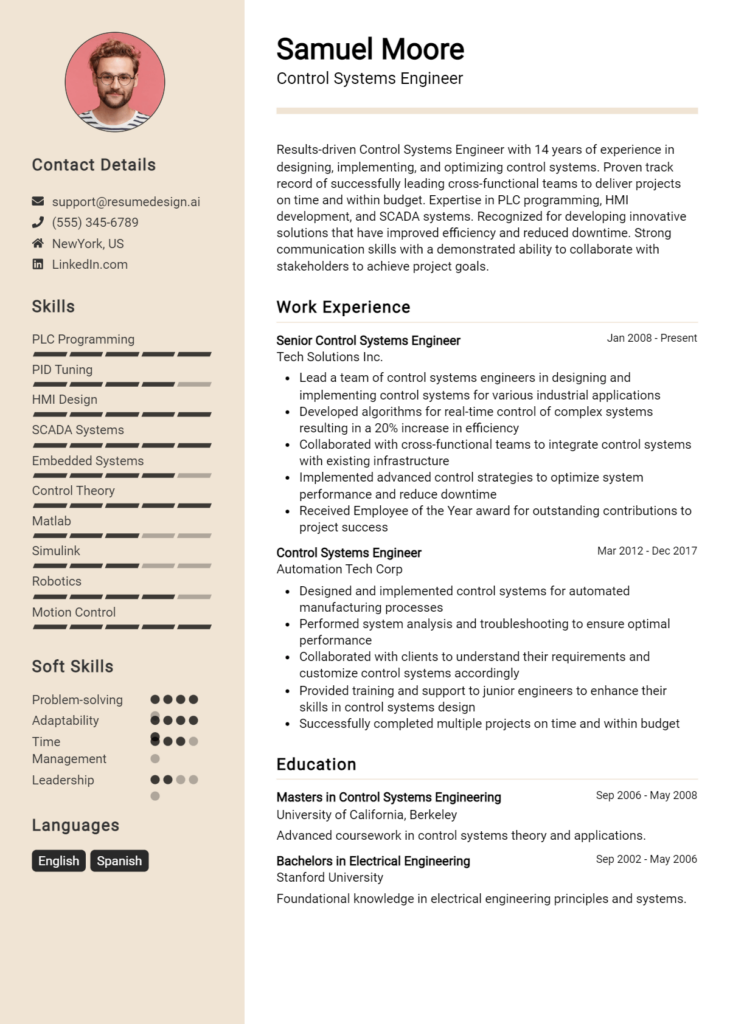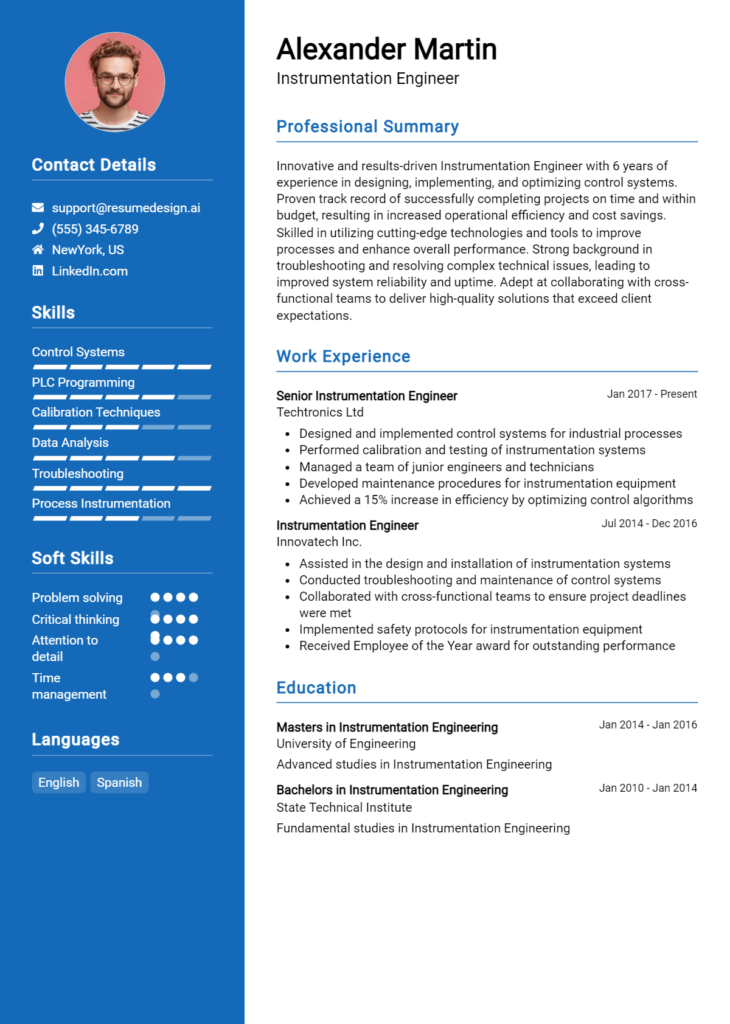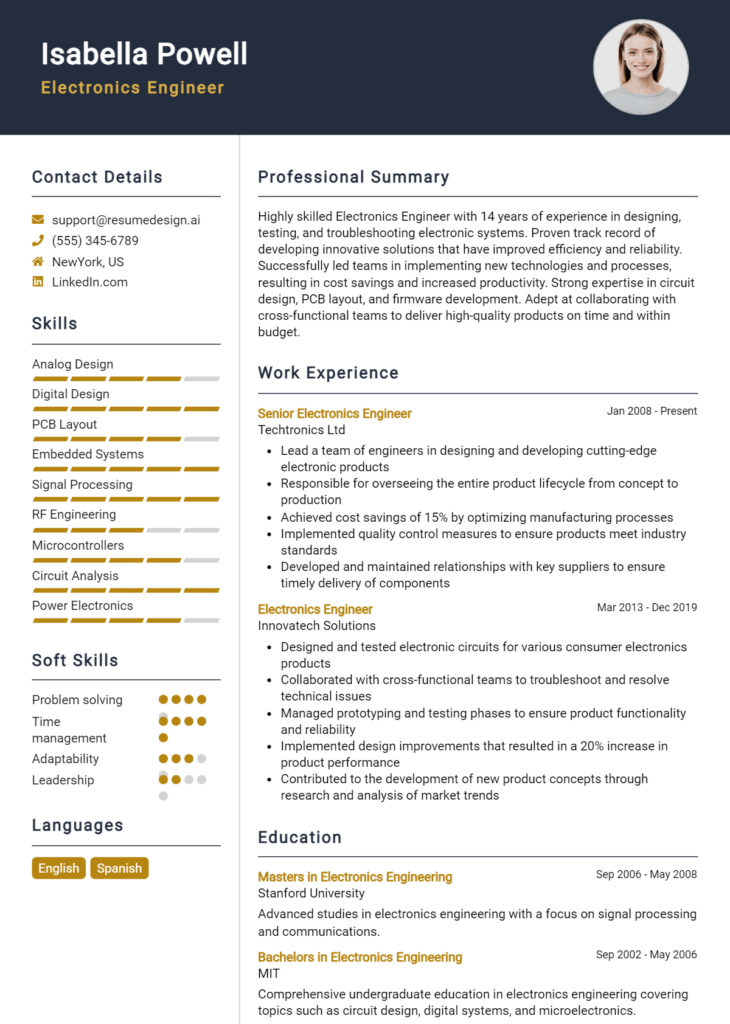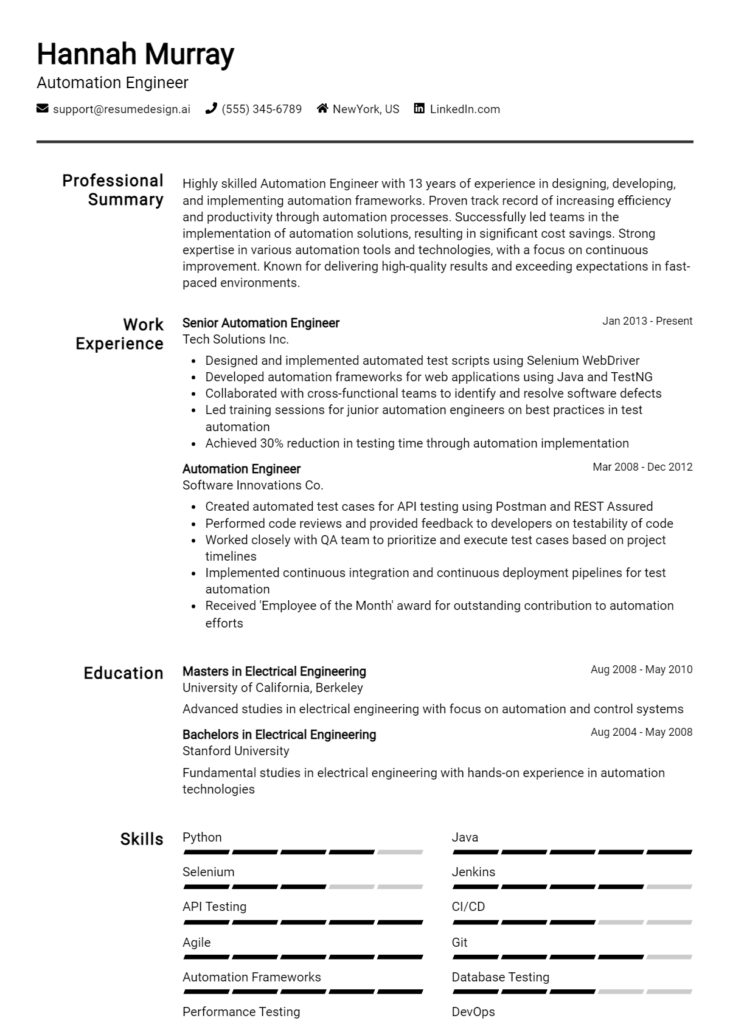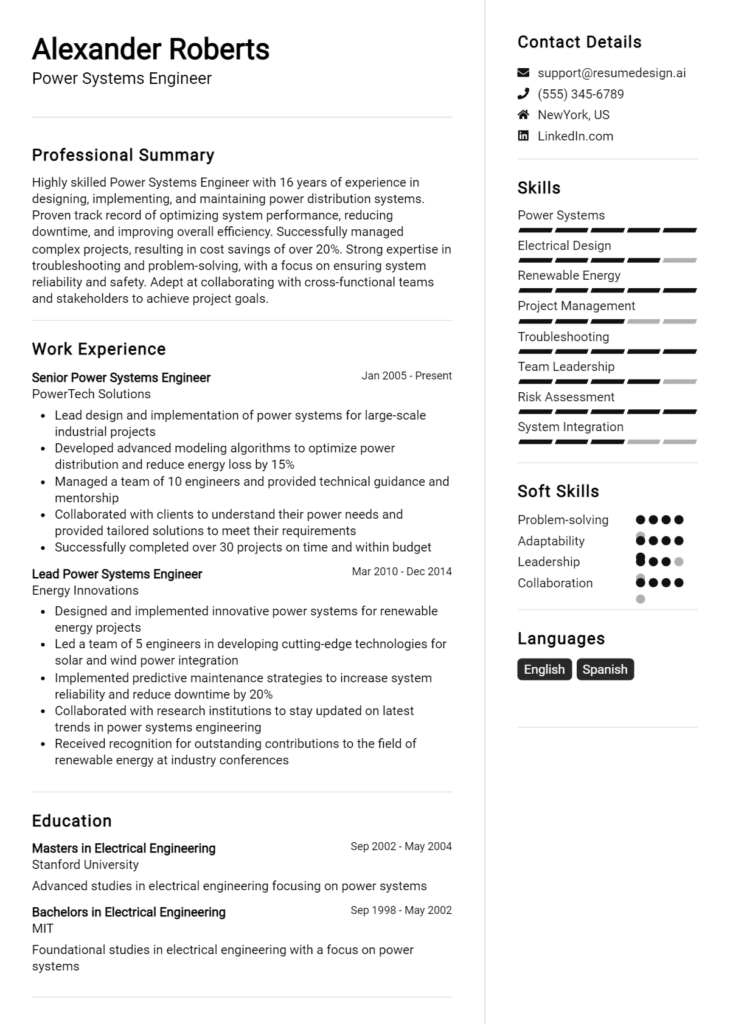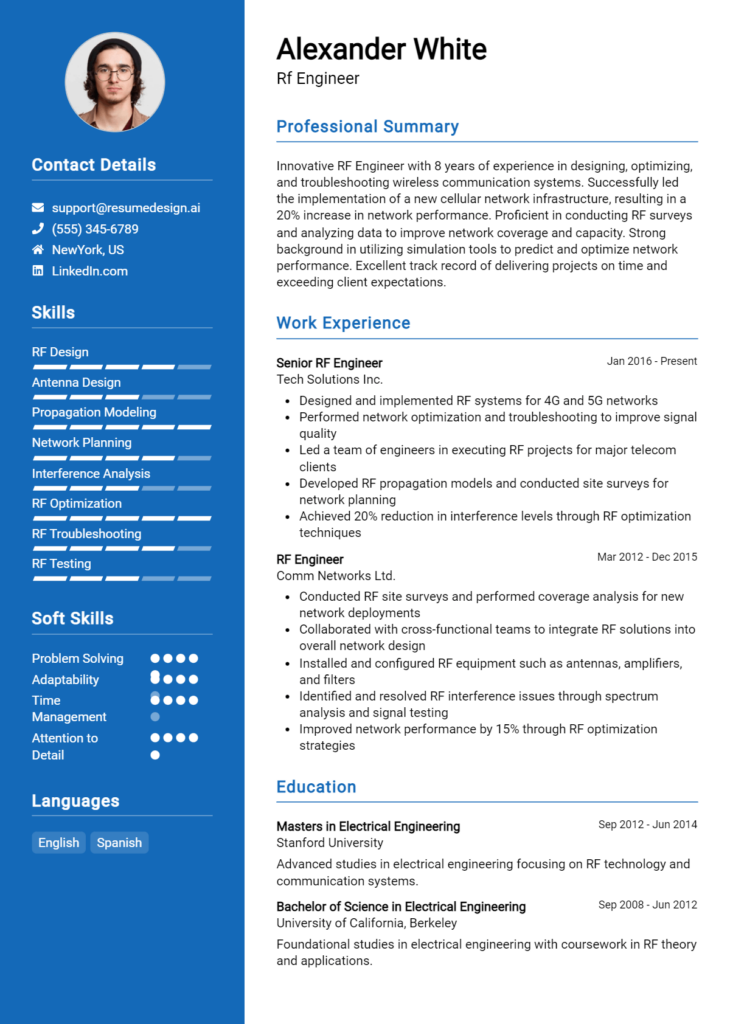VLSI Design Engineer Core Responsibilities
A VLSI Design Engineer plays a crucial role in the development of integrated circuits, bridging the gap between design, testing, and manufacturing departments. Key responsibilities include designing and optimizing circuit layouts, conducting simulations, and collaborating with cross-functional teams to resolve technical challenges. Essential skills encompass strong analytical and problem-solving abilities, proficiency in hardware description languages, and knowledge of semiconductor physics. A well-crafted resume highlighting these competencies is vital for demonstrating how they align with the organization's goals, enhancing the candidate's prospects in a competitive field.
Common Responsibilities Listed on VLSI Design Engineer Resume
- Design and develop VLSI circuits and systems
- Conduct simulations and performance analysis of designs
- Collaborate with software and hardware teams for integration
- Optimize circuit layouts for performance and area
- Debug and troubleshoot design issues
- Participate in design reviews and provide technical feedback
- Prepare documentation and reports on design progress
- Stay updated on industry trends and emerging technologies
- Utilize EDA tools for design and verification processes
- Ensure compliance with design specifications and industry standards
- Mentor junior engineers and interns on best practices
High-Level Resume Tips for VLSI Design Engineer Professionals
In the competitive field of VLSI Design Engineering, a well-crafted resume is not just a formality; it is your first opportunity to make a lasting impression on potential employers. Your resume serves as a powerful marketing tool that showcases not only your technical skills but also your achievements and experiences. It should reflect your capabilities in a way that resonates with the specific needs of the industry and the role you are aiming for. This guide will provide you with practical and actionable resume tips specifically tailored for VLSI Design Engineer professionals, helping you to stand out in a crowded job market.
Top Resume Tips for VLSI Design Engineer Professionals
- Tailor your resume for each job application by incorporating keywords from the job description.
- Highlight your relevant experience in VLSI design, including specific projects and technologies you have worked with.
- Quantify your achievements with metrics, such as improvements in design efficiency or reductions in time-to-market.
- Showcase your proficiency with industry-standard tools and software, such as Cadence, Synopsys, or Mentor Graphics.
- Include a dedicated section for certifications and training relevant to VLSI design and development.
- Utilize clear and concise formatting to enhance readability and emphasize key accomplishments.
- Incorporate a brief summary at the top of your resume that encapsulates your expertise and career goals.
- List any contributions to publications, patents, or conferences that demonstrate your thought leadership in the field.
- Make sure to include soft skills, such as teamwork and communication, that are essential for collaborative engineering environments.
- Review and proofread your resume to eliminate any errors and ensure clarity and professionalism.
By implementing these tips, you can significantly enhance your resume and increase your chances of landing a job in the VLSI Design Engineer field. A well-structured resume that effectively showcases your skills and achievements will not only attract the attention of hiring managers but also demonstrate your commitment to excellence in your profession.
Why Resume Headlines & Titles are Important for VLSI Design Engineer
In the competitive field of VLSI Design Engineering, a well-crafted resume headline or title can be a game-changer. It serves as the first impression for hiring managers, succinctly summarizing a candidate's qualifications and capturing their attention right from the start. A strong headline should encapsulate the core competencies, relevant experience, and unique value the candidate brings to the table, all within a concise phrase. By effectively communicating one's expertise and alignment with the job role, a compelling headline can significantly increase the chances of passing initial screenings and prompting further review of the resume.
Best Practices for Crafting Resume Headlines for VLSI Design Engineer
- Keep it concise, ideally under 10 words.
- Make it role-specific to target VLSI Design Engineering positions.
- Highlight key skills or technologies relevant to the job.
- Use action-oriented language to convey impact.
- Incorporate any certifications or specialized training.
- Avoid vague terms; be specific about your expertise.
- Align the headline with the job description to demonstrate fit.
- Consider including measurable achievements when applicable.
Example Resume Headlines for VLSI Design Engineer
Strong Resume Headlines
"Innovative VLSI Design Engineer with 5+ Years in ASIC Development"
“Expert in Low-Power VLSI Design and Verification Techniques”
"Dynamic VLSI Engineer Specializing in RTL Design and Synthesis"
"Results-Driven VLSI Designer with Proven Track Record in Tape-Out Success"
Weak Resume Headlines
“Engineer Looking for Opportunities”
“VLSI Design Engineer with Experience”
The strong headlines are effective because they not only specify the candidate's role and area of expertise but also highlight relevant experience and accomplishments, making them stand out in a crowded job market. In contrast, the weak headlines lack specificity and fail to communicate any unique value or qualifications, which can lead to them being overlooked by hiring managers. A strong headline should convey clarity and purpose, while a weak one leaves too much to the imagination, failing to capture interest.
Writing an Exceptional VLSI Design Engineer Resume Summary
A resume summary is a crucial element for a VLSI Design Engineer's application, as it serves as a powerful first impression for hiring managers. In a competitive job market, a strong summary can quickly capture attention by succinctly showcasing key skills, relevant experience, and notable accomplishments that align with the job role. It should be concise, impactful, and meticulously tailored to the specific job the candidate is applying for, ensuring that it highlights what makes them an ideal fit for the position.
Best Practices for Writing a VLSI Design Engineer Resume Summary
- Quantify Achievements: Use numbers and percentages to highlight your successes and contributions, making your impact clear.
- Focus on Key Skills: Identify and emphasize the most relevant technical and soft skills that align with the job description.
- Tailor for the Job Description: Customize your summary for each application, reflecting the specific needs and requirements outlined in the job posting.
- Keep it Concise: Aim for 3-5 sentences that provide a snapshot of your qualifications without overwhelming the reader.
- Highlight Relevant Experience: Prioritize showcasing your most pertinent work experiences that demonstrate your capability in VLSI design.
- Use Action-Oriented Language: Employ strong action verbs to convey your contributions and achievements effectively.
- Showcase Industry Knowledge: Mention any specific tools, technologies, or methodologies in VLSI design that you are proficient in.
- Emphasize Problem-Solving Skills: Illustrate instances where you have successfully solved complex engineering problems or improved processes.
Example VLSI Design Engineer Resume Summaries
Strong Resume Summaries
Innovative VLSI Design Engineer with over 5 years of experience in developing high-performance integrated circuits, yielding a 30% increase in data throughput for client projects. Proficient in Verilog and SystemVerilog, with a proven track record of reducing design cycles by 25% through effective project management and collaboration.
Results-driven VLSI Design Engineer with expertise in RTL design and verification, leading to a 15% reduction in silicon turnaround time. Adept in utilizing Cadence and Synopsys tools, with a strong foundation in digital signal processing and low-power design techniques.
Detail-oriented VLSI Design Engineer with a background in ASIC design, achieving a 40% improvement in power efficiency for consumer electronics. Skilled in implementing design for testability (DFT) strategies, leading to a 50% decrease in post-silicon debug time.
Weak Resume Summaries
Experienced engineer looking for opportunities in VLSI design. I have worked on several projects and have some skills in digital design.
Motivated VLSI engineer with a variety of experiences in the industry. I am seeking a job that will allow me to use my skills.
The strong resume summaries effectively highlight specific skills, quantifiable achievements, and direct relevance to the VLSI Design Engineer role, showcasing the candidate's value to potential employers. In contrast, the weak summaries are vague and generic, lacking concrete examples and measurable outcomes, making it difficult for hiring managers to gauge the candidates' qualifications and fit for the position.
Work Experience Section for VLSI Design Engineer Resume
The work experience section of a VLSI Design Engineer resume is critical in demonstrating the candidate's technical capabilities and real-world application of their skills. It serves as a platform to showcase not only individual technical expertise but also the ability to collaborate within teams and deliver high-quality products on time. By providing quantifiable achievements and aligning experiences with industry standards, candidates can effectively highlight their contributions to past projects and their readiness to tackle new challenges in the VLSI domain.
Best Practices for VLSI Design Engineer Work Experience
- Clearly outline your technical skills related to VLSI design, such as proficiency in hardware description languages (HDLs) like Verilog or VHDL.
- Quantify your achievements with specific metrics, such as reduced design cycles or improved performance metrics.
- Highlight your role in team projects, showcasing your ability to collaborate and lead cross-functional teams.
- Include relevant industry certifications or training to reinforce your expertise.
- Tailor your experiences to match the requirements of the job you are applying for, aligning terminology and focus areas.
- Use action verbs to convey impact and involvement in projects.
- Summarize complex projects succinctly, focusing on your contributions and the outcomes achieved.
- Maintain consistency in formatting and style to enhance readability and professionalism.
Example Work Experiences for VLSI Design Engineer
Strong Experiences
- Led a team of 5 engineers in the successful design and verification of a 16nm SoC, achieving a 30% reduction in power consumption compared to previous models.
- Developed and optimized a custom RTL design that improved throughput by 25%, directly contributing to the product's time-to-market.
- Collaborated with cross-disciplinary teams to implement a DFT strategy that increased test coverage by 40%, resulting in a significant decrease in post-silicon debug time.
- Managed the transition of a legacy design to a new architecture, improving performance by 50% while maintaining compliance with all industry standards.
Weak Experiences
- Worked on various projects related to VLSI design.
- Participated in team meetings to discuss design issues.
- Involved in the verification of designs.
- Assisted in the development of some design documentation.
The experiences listed as strong demonstrate clear achievements, measurable outcomes, and leadership in technical projects, showcasing the candidate's ability to deliver impactful results. In contrast, the weak experiences lack specificity and quantifiable results, making it difficult to ascertain the candidate's contributions or the impact of their work within the VLSI field. Strong experiences also emphasize collaboration and technical leadership, which are essential traits for a VLSI Design Engineer.
Education and Certifications Section for VLSI Design Engineer Resume
The education and certifications section of a VLSI Design Engineer resume is crucial as it showcases the candidate's academic background, industry-relevant certifications, and commitment to continuous learning. This section serves to emphasize the qualifications that align with the demands of the role, providing potential employers with insight into the applicant's technical expertise and foundational knowledge. By including relevant coursework, specialized training, and recognized certifications, candidates can greatly enhance their credibility and demonstrate their preparedness for the challenges associated with VLSI design engineering.
Best Practices for VLSI Design Engineer Education and Certifications
- Include only relevant degrees and certifications that align with VLSI design roles.
- List educational qualifications in reverse chronological order, starting with the most recent.
- Highlight advanced or industry-recognized credentials, such as a Master’s degree or specific design certifications.
- Include relevant coursework that directly pertains to VLSI design, such as digital circuits or semiconductor physics.
- Be specific about certifications, mentioning the certifying body and the year obtained.
- Consider adding any specialized training or workshops attended that enhance your skill set.
- Maintain a clear and organized format to make the information easily accessible.
- Avoid including outdated or irrelevant certifications that do not contribute to your current qualifications.
Example Education and Certifications for VLSI Design Engineer
Strong Examples
- M.S. in Electrical Engineering, University of California, Berkeley, 2022
- Certified VLSI Design Engineer (CVDE), VLSI Design Certification Board, 2023
- Relevant Coursework: Advanced Digital System Design, VLSI Circuit Design, and ASIC Design Principles.
- Specialized Training: Advanced FPGA Design Workshop, 2023
Weak Examples
- B.A. in History, State University, 2018
- Certification in Microsoft Excel, 2020
- Relevant Coursework: Introduction to Psychology
- Old Certification: Basic Electronics Course, 2015
The strong examples are characterized by their relevance to the VLSI Design Engineer role, showcasing advanced degrees and certifications that are recognized in the industry. They align closely with the skills and knowledge required for the position. In contrast, the weak examples feature educational qualifications and certifications that are either irrelevant or outdated, demonstrating a lack of focus on the specific competencies needed for a successful career in VLSI design engineering.
Top Skills & Keywords for VLSI Design Engineer Resume
In the competitive field of VLSI (Very Large Scale Integration) design engineering, a well-crafted resume is essential to stand out among other candidates. The importance of skills cannot be overstated, as they are the key indicators of your capabilities and potential contributions to an organization. Highlighting both hard and soft skills effectively showcases not only your technical proficiency but also your ability to collaborate and communicate within a team environment. A balanced combination of these skills will resonate with hiring managers, making it crucial to tailor your resume to reflect the most relevant qualifications for the role. For more insights on how to effectively present your skills, check out our guide on skills.
Top Hard & Soft Skills for VLSI Design Engineer
Soft Skills
- Problem-Solving
- Team Collaboration
- Time Management
- Attention to Detail
- Communication Skills
- Adaptability
- Critical Thinking
- Creativity
- Leadership
- Project Management
Hard Skills
- VLSI Design Tools (e.g., Cadence, Synopsys)
- RTL Design (Register Transfer Level)
- Verilog/VHDL Programming
- ASIC Design Methodologies
- FPGA Development
- Timing Analysis
- Schematic Capture
- Circuit Simulation
- Layout Design
- Digital Signal Processing
Emphasizing these hard and soft skills in your resume can significantly increase your chances of landing an interview and ultimately securing a position as a VLSI Design Engineer.
Stand Out with a Winning VLSI Design Engineer Cover Letter
Dear Hiring Manager,
I am writing to express my interest in the VLSI Design Engineer position at [Company Name] as advertised on [Job Board/Company Website]. With a Master's degree in Electrical Engineering and over [X years] of hands-on experience in VLSI design and verification, I am excited about the opportunity to contribute to your team. My background in digital circuit design, combined with my proficiency in tools such as Cadence, Synopsys, and ModelSim, has equipped me with the skills necessary to excel in this dynamic field.
At [Previous Company Name], I successfully led a project that involved the design and implementation of a low-power digital signal processing unit, which not only met but exceeded performance expectations while reducing power consumption by 30%. My ability to collaborate with cross-functional teams has allowed me to effectively translate complex requirements into functional specifications, ensuring that the final designs align with project goals and timelines. I am particularly proud of my work in optimizing layouts for manufacturability, which resulted in a significant reduction in silicon area and costs.
I am passionate about staying up-to-date with the latest advancements in VLSI technology and methodologies. My involvement in ongoing professional development, such as attending industry conferences and participating in workshops, has further enhanced my design techniques and problem-solving skills. I am eager to bring this knowledge to [Company Name] and contribute to innovative projects that push the boundaries of VLSI design.
Thank you for considering my application. I am looking forward to the opportunity to discuss how my experience and vision align with the goals of [Company Name]. I am excited about the prospect of contributing to your team and am available for an interview at your earliest convenience.
Sincerely,
[Your Name]
[Your Contact Information]
[LinkedIn Profile or Portfolio Link]
Common Mistakes to Avoid in a VLSI Design Engineer Resume
When crafting a resume for a VLSI Design Engineer position, it’s essential to present your skills and experiences effectively to stand out in a competitive job market. However, many candidates make common mistakes that can undermine their chances of landing an interview. Here are several pitfalls to avoid when creating your resume:
Lack of Specific Technical Skills: Failing to list relevant tools and technologies, such as HDL (VHDL/Verilog), simulation tools (Cadence, ModelSim), or synthesis tools (Synopsys), can make your resume less appealing to recruiters who seek specific expertise.
Generic Job Descriptions: Using vague terms like "worked on projects" instead of detailing your specific contributions and outcomes can make your resume blend into the crowd. Be specific about your role and the impact of your work.
Ignoring Keywords: Many companies use Applicant Tracking Systems (ATS) to filter resumes. Not incorporating industry-relevant keywords from the job description can result in your resume being overlooked.
Poor Formatting: A cluttered or overly complex layout can distract from your accomplishments. Ensure your resume is clean, easy to read, and follows a logical structure.
Overemphasis on Education: While education is important, especially in a technical field, overemphasizing it at the expense of practical experience can mislead hiring managers. Focus on relevant projects and skills instead.
Neglecting Achievements: Simply listing responsibilities without highlighting specific achievements (like project successes, performance improvements, or awards) can make your resume less compelling. Use quantifiable metrics where possible.
Typos and Grammatical Errors: Mistakes in grammar or spelling can create a negative impression and suggest a lack of attention to detail. Always proofread your resume before submission.
Too Much Information: Including every job you’ve ever had can dilute the impact of your relevant experience. Prioritize information that aligns with the VLSI design role and streamline your content for clarity.
Conclusion
As we conclude our exploration of the VLSI Design Engineer role, it's essential to reflect on the critical skills and experiences that define this position. VLSI Design Engineers are responsible for designing complex integrated circuits, requiring expertise in areas such as digital and analog circuit design, semiconductor physics, and proficiency with various design tools and methodologies. The ability to work collaboratively within a multidisciplinary team and adapt to emerging technologies is also crucial for success in this field.
To ensure that you stand out in the competitive job market, take a moment to review and enhance your VLSI Design Engineer resume. Highlight your technical skills, relevant experiences, and projects that showcase your capabilities.
For assistance in creating a professional and impactful resume, consider utilizing the following resources:
- Resume templates to give your document a polished look.
- Resume builder for an easy and guided resume creation process.
- Resume examples to inspire your content and structure.
- Cover letter templates to complement your resume and make a strong impression.
Don't miss the opportunity to present yourself as the ideal candidate for VLSI Design Engineer positions. Start refining your resume today!

